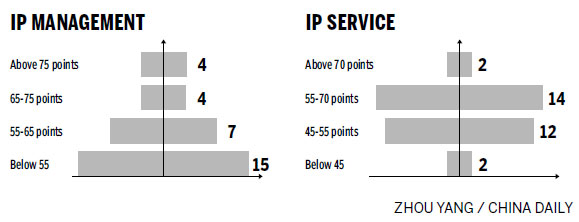

Intellectual property growth region by region across China is directly related to economic growth, according to a report released last week at a national IP conference in Fuzhou, Fujian province.
The State Intellectual Property Office, the State Administration for Industry and Commerce and the National Copyright Administration jointly launched a survey in July 2013 to study how the national IP strategy had been implemented since 2008.
The survey covered 30 sample provinces and regions on the Chinese mainland over the five years, and looked at how they made and carried out their own IP strategies.
"The targets and measures of the national strategy are elaborated in local strategies," said Huang Qing, director of SIPO's protection and coordination department, at the conference.
"Many provinces and regions are shifting their focus from the expansion of IP in numbers to the increase of quality and profit that IP brings about."
Beijing-based consultation firm Greatwall Enterprise Institute also took part in the evaluation as an independent assessor. Huang said the introduction of a third party is "an innovation in both work concept and government management model".
The report has found that those regions with stronger IP capacity are located in Southeast China and the Bohai Bay economic rim, which also represent "the most economically dynamic areas" in the nation.
Meanwhile, the "weaker" regions are mostly less advanced areas in Northwest China.
Beijing, Guangdong and Shanghai rank top three in the list, with the last three places going to Inner Mongolia, Gansu and Ningxia.
The report has found "significant differences" in the scores of different regions, which show that the "strong" regions failed to push forward the IP business of the "weak" ones near them.
Twenty-five provinces and regions met the phase requirement of their local IP strategies, and the other five failed only by "slight gaps", the report said.
But it also noted that even the backward regions had made "substantial progress" in IP.
Wang Chenggang, a manager and partner of Greatwall Enterprise Institute, said that the failed regions featured traditional economic models that relied on natural resources. He called for more government support to help restructure their economies.
The ranking assessed IP creation, use, protection, management and service in different regions in 90 detailed dimensions.
The score distribution in the categories of IP creation and management features a pyramid style, in which very few regions gained high scores while most of them gained very low scores.
The score distribution in IP protection has the shape of a spinning top, where most regions are in the low-score area near the bottom.
The score distribution in IP use shows a "dumbbell" shape, where most regions gather at both ends, with the bottom larger than the top. The report noted that the top ones have advanced markets.
IP service showed the opposite pattern, with scores in a spindle-shaped distribution, in which few regions gain very high or very low scores, and most of them stay at an average level.
"Improved regional IP strategies that interact with the national strategy will increasingly support China's socioeconomic development," said SIPO Commissioner Shen Changyu.
But he also said there are challenges ahead, including insufficient IP commercialization and protection that fail to meet public expectations.
The commissioner called for measures by local governments that will encourage innovation in small companies.
